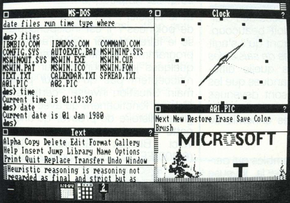Windows 1.0 1983-11-20 build
| Build of Windows 1.0 | |
 | |
| OS family | 16-bit Windows |
|---|---|
| Version number | 1.00 |
| Architecture | x86 16-bit |
| Compiled on | 1983-11-20 |
The Windows 1.0 1983-11-20 build is an early build of Windows 1.0 from late 1983, extensively photographed by French computer magazine L'Ordinateur Individuel[a] and published in their February 1984 issue,[1] while other photos were published in the May 1984 issue of Japanese computer magazine 月刊アスキー.[b][2] The French article includes a total of 10 high quality close up photos. There has been some debate whether this is actually several different builds or not, though neither theory can be 100% confirmed.
L'Ordinateur Individuel photographs[edit | edit source]
Applications[edit | edit source]
The photographs were taken at a rather high quality, which was rare at the time. The running applications are Art, Calendar, Clock, MS-DOS, Spread Sheet and Text. A01.PIC was the famous Microsoft I picture and TEXT.TXT was the Heuristic Reasoning text seen in many demo builds. A02.PIC, however, is not the Microsoft II picture, instead it was perhaps made by L'Ordinateur Individuel for demonstration purposes.
MS-DOS[edit | edit source]
The MS-DOS shell at this stage was very primitive, it looks like COMMAND.COM in DOS but is actually the shell and predecessor of the MS-DOS Executive in later builds. The menu provides date, files, run, time, type and where commands. Those commands are equivalent to DATE, DIR, RUN, TIME, TYPE and CD in MS-DOS. The ability to run MS-DOS apps was not implemented until the Alpha release in January 1985.
The status bar[edit | edit source]
The status bar in the first two pictures shows Microsoft Windows Version 1.00 (11/20/83), suggesting the compilation date. The status bar in the other pictures is mostly empty, except when resizing a window it shows Set new column width. Both buttons cancel.. Clicking the menu button in the top right corner reveals the options to display the system time and date, to save the current session, and to end the session (leave Windows).
File list[edit | edit source]
Files shown:
A01.PIC, A02.PIC: Sample images displayed by the Art application.AUTOEXEC.BAT, COMMAND.COM, CONFIG.SYS, IBMBIO.COM, IBMDOS.COM: MS-DOS or PC DOS 2.x system files. It suggests this build might have been a bootable demo disk or installed to hard drive in the same directory as DOS.CALENDAR.TXT: Plain text file used by the Calendar application.MSWININP.SYS, MSWINOUT.SYS: Windows Input/Output drivers.MSWIN.CUR: A cursor used by Windows.MSWIN.EXE: The main Windows executable, possibly used to start Windows.MSWIN.FON: A font used by Windows.MSWIN.ICO: An icon used by Windows, possibly the MS-DOS Executive icon.MSWIN.PAT: Perhaps a resource file used by Windows. The extension suggests it might be a pattern file or related to patterns.SPREAD.TXT: Plain text file used by the Spread Sheet application.TEXT.TXT: The Heuristic Reasoning text displayed by the Text application.
The executables of Art, Calendar, Clock, Spread Sheet and Text applications are not listed, suggesting they might have been on a separate disk or possibly even contained within MSWIN.EXE itself.
Gallery[edit | edit source]
Monthly ASCII photographs[edit | edit source]
These photographs were published in the May 1984 issue of Japanese magazine 月刊アスキー.[b][3] Like the above photos, they reveal the same version string in the status bar.
Notes[edit | edit source]
- ↑ English: The Personal Computer
- ↑ Jump up to: 2.0 2.1 English: Monthly ASCII
References[edit | edit source]
- ↑ https://blog.krnl386.com/index.php?post/2019/03/01/Evolution-of-Windows-1.0-part-9%3A-1983/11/20-build
- ↑ https://blog.krnl386.com/index.php?post/2018/10/07/Evolution-of-Windows-1.0-part-8%3A-November-1983-builds
- ↑ https://web.archive.org/web/20190317123000/http://home.att.ne.jp/gold/kazooou/comhis/













